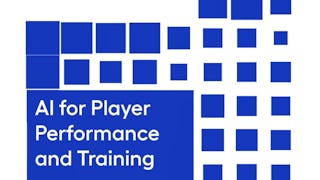Sports analytics now include massive datasets from athletes and teams that quantify both training and competition efforts. Wearable technology devices are being worn by athletes everyday and provide considerable opportunities for an in-depth look at the stress and recovery of athletes across entire seasons. The capturing of these large datasets has led to new hypotheses and strategies regarding injury prevention as well as detailed feedback for athletes to try and optimize training and recovery.

Gain next-level skills with Coursera Plus for $199 (regularly $399). Save now.

Wearable Technologies and Sports Analytics
This course is part of Sports Performance Analytics Specialization

Instructor: Peter F. Bodary
4,992 already enrolled
Included with
(44 reviews)
Recommended experience
What you'll learn
Understand how wearable devices can be used to help characterize both training and performance.
Skills you'll gain
Details to know

Add to your LinkedIn profile
11 assignments
See how employees at top companies are mastering in-demand skills

Build your subject-matter expertise
- Learn new concepts from industry experts
- Gain a foundational understanding of a subject or tool
- Develop job-relevant skills with hands-on projects
- Earn a shareable career certificate

There are 5 modules in this course
In this module, we will introduce different types of wearable devices that are used by athletes and teams to improve training and recovery. We will start by highlighting what types of sensors are used within the wearable devices and how the data coming from these sensors can provide insights, such as training intensity and or physiologic “readiness”.
What's included
4 videos7 readings2 assignments1 app item2 ungraded labs
In this module, we will focus on what we have introduced as “external” measures. We will point out some of the (inaccurate) assumptions that are made regarding external measures of “load” and “effort”. In addition, we will outline how the continuous use of wearable devices has led to new opportunities for quantifying effort as well as (in theory) reducing injury and improving performance. We will finish by describing the “acute to chronic workload” and the reasons it has gained a lot of attention in the past several years.
What's included
3 videos3 readings3 assignments2 app items1 discussion prompt2 ungraded labs
In this module, we will dive more into the physiology of training and recovery, focusing on what we have introduced as “internal” measures. We will further explore the use of internal sensors to provide a glimpse of how the individual athlete is responding to the stress induced by training and/or competition. We will also highlight the pros and cons of using internal measures to evaluate individual and team training and recovery.
What's included
5 videos2 readings2 assignments1 app item1 discussion prompt2 ungraded labs
In this module, we combine external and internal measures to provide a much more nuanced look at training and recovery. The external measures can provide a highly quantified evaluation of the movements and motions that have taken place, while the internal measures provide feedback about how the athlete is tolerating the training. Combining them can be instrumental for evaluating performance improvements and preventing or reducing overuse injuries.
What's included
3 videos5 readings2 assignments1 app item2 ungraded labs
In this module, we will discuss the exciting new global metrics that have been developed and/or used by many of the consumer devices that are available today. Although these new metrics are exciting, we want to be cognizant of the limitations of these devices. Therefore, we will discuss what sensors are actually employed to provide these new metrics and highlight where validation is feasible.
What's included
5 videos5 readings2 assignments1 app item2 ungraded labs
Earn a career certificate
Add this credential to your LinkedIn profile, resume, or CV. Share it on social media and in your performance review.
Instructor

Offered by
Explore more from Data Analysis
 Status: Free Trial
Status: Free TrialReal Madrid Graduate School Universidad Europea
 Status: Free Trial
Status: Free TrialUniversity of Michigan
 Status: Free Trial
Status: Free TrialUniversity of Michigan
 Status: Free Trial
Status: Free TrialUniversity of Michigan
Why people choose Coursera for their career




Learner reviews
44 reviews
- 5 stars
65.90%
- 4 stars
22.72%
- 3 stars
6.81%
- 2 stars
2.27%
- 1 star
2.27%
Showing 3 of 44
Reviewed on Oct 12, 2024
Suitable course materials, good quizzes and perfect teaching style by professor Peter Brodary
Reviewed on Nov 24, 2021
Love this course, love the content, love the assignments and Peter is great at explaining the terms and concepts
Frequently asked questions
To access the course materials, assignments and to earn a Certificate, you will need to purchase the Certificate experience when you enroll in a course. You can try a Free Trial instead, or apply for Financial Aid. The course may offer 'Full Course, No Certificate' instead. This option lets you see all course materials, submit required assessments, and get a final grade. This also means that you will not be able to purchase a Certificate experience.
When you enroll in the course, you get access to all of the courses in the Specialization, and you earn a certificate when you complete the work. Your electronic Certificate will be added to your Accomplishments page - from there, you can print your Certificate or add it to your LinkedIn profile.
Yes. In select learning programs, you can apply for financial aid or a scholarship if you can’t afford the enrollment fee. If fin aid or scholarship is available for your learning program selection, you’ll find a link to apply on the description page.
More questions
Financial aid available,





